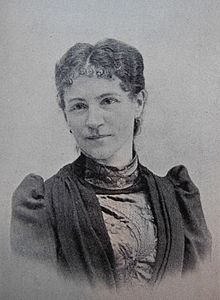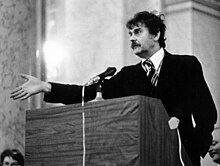Bavarian dialect literature
Bavarian dialect literature in the broader regional sense includes all literature that is written in a Bavarian dialect. This includes works by authors from Old Bavaria , Austria and South Tyrol through to the Bavarian language islands in Italy, Romania and South America. In the diachronic sense, one speaks of dialect literature only from the late baroque period , i.e. from around the year 1750, since there was previously no uniform German standard language and the difference between written dialect and a particularly dialectically colored Upper German writing language was fluent, as was the case with the old German. Viennese folk theater pieces by Joseph Anton Stranitzky .
Demarcation
Not counting in Bavarian dialect literature, however, are some of the prominent local poets from the region, who often wrote idyllically about the life of farmers, lumberjacks, dairymen, poachers and mountaineers or the rural customs in Bavaria and Austria, but whose works are written in full are written in standard German . These include the Upper Austrian Adalbert Stifter (1805–1868), the Salzburg Karl Heinrich Waggerl (1897–1973), the Lower Styrian Ottokar Kernstock (1848–1928) and the South Tyrolean Luis Trenker (1892–1990). Furthermore, with many authors, especially of the 19th and early 20th centuries, only a few works are actually written in dialect, for example with the playwrights often only parts of the dialogues, while the play as a whole was written in standard German. For example, there are very few texts by Ludwig Thoma and Peter Rosegger that are consistently written in dialect.
A modern literary phenomenon are texts that use dialectal idioms and vocabulary as well as slang grammar, for example through the consistent use of the perfect tense instead of the past tense , but the spelling remains completely high-level. Readers with dialect competence can translate such texts directly into the dialect while reading and often do not have the conscious impression of having read a standard-language text. A prominent representative of this genre in Austria is the crime novelist Wolf Haas , or the interwar playwright Jura Soyfer, often referred to as the " Austrian Bert Brecht " . The commercial advantage of these works is that readers from different Bavarian dialect regions can read the text in their head like their own dialect and thus a wider audience can be reached than, for example, with an actual dialect work in, for example, Viennese, Tyrolean or Upper Bavarian.
Dialect authors
The following is a list of the most famous Bavarian-speaking dialect authors, sorted by era and dialect region:
Late baroque
- playwright
- Ignatz Anton Weiser (1701–1785), Salzburg
- Maurus Lindemayr (1723–1783), Upper Austria
- Florian Reichssiegel (1735–1793), Salzburg
enlightenment
- Dialect researcher
- Johann Siegmund Popowitsch (1705–1774), Lower Styria / Slovenia
- Carl Friedrich Aichinger (1717–1782), Upper Palatinate
- Andreas Dominikus Zaupser (1746–1795), Upper Palatinate
romance
- Dialect researcher
- Johann Andreas Schmeller (1785–1852), Upper Palatinate
- poet
- Johann Gabriel Seidl (1804–1875), Vienna
- Song and fairy tale collector
- Julius Max Schottky (1797–1849), Bohemia
- Franz Tschischka (Žiška; 1786–1855), Lower Austria
- Johann Wurth (1828–1870), Lower Austria
- Joseph Maria Wagner (1838–1879), Vienna
- playwright
- Ignaz Franz Castelli (1781–1862), Vienna
- Johann Nepomuk Nestroy (1801–1862), Vienna
- Franz Graf von Pocci (1807–1876), Munich
- Alexander Baumann (1814–1857), Styria
- Literati
- Franz Stelzhamer (1802–1874), Upper Austria
- Carl Adam Kaltenbrunner (1804–1867), Upper Austria
Late 19th century
- playwright
- Franz von Kobell (1803–1882), Munich
- Johann Nepomuk Sepp (1816–1909), Upper Bavaria
- Ludwig Anzengruber (1839–1889), Vienna
- poet
- Franz Stelzhamer (1802–1874), Upper Austria
- Josef Misson (1803–1875), Lower Austria
- Norbert Hanrieder (1842–1913), Upper Austria
- Karl Stieler (1842–1885), Munich
- Peter Rosegger (1843–1918), Styria
Early 20th century
- poet
- Hans Zötl (1846–1938), Upper Austria
- Anton Matosch (1851–1918), Upper Austria
- Elise Beck (1855–1912), Lower Bavaria
- Ludwig Ganghofer (1855–1920), Swabia
- Hans Fraungruber (1863–1933), Styria
- Otto Plantl (1865–1943), Salzburg
- Ludwig Thoma (1867–1921), Upper Bavaria
- Hans Kloepfer (1867–1944), Styria
- Wilhelm Dusch (1871–1927), Upper Bavaria
- Anna Schuster (1872–1939), Upper Bavaria
- Otto Piringer (1874–1950), Landler from Transylvania
- Oskar Maria Graf (1894–1967), Upper Bavaria
- Ödön von Horváth (1901–1938), Austria-Hungary
- playwright
- Julius Beck (1852–1920), Munich
- Josef Ruederer (1861–1915), Munich
- Georg Queri (1879–1919), Munich
post war period
- playwright
- Paul Schallweg (1914–1998), Munich
- Martin Sperr (1944–2002), Lower Bavaria
- Joe Berger (1939–1991), Lower Austria
- poet
- Otto Jungmair (1889–1974), Upper Austria
- Gerhard Glawischnig (1906–1995), Carinthia
- Wally Fendt (1907–1979), Upper Bavaria
- HC Artmann (1921–2000), Vienna
- Ludwig Gruber (1922–2005), Lower Bavaria
- Literati
- Gottfried Glechner (1916–2004), Innviertel
- Friedl Brehm (1917–1983), Upper Bavaria
- Gerhard Bronner (1922–2007), Vienna
- Walter Bäck (1931–2004), Vienna
- Wolfgang Teuschl (1943–1999), Vienna
Contemporary literature
- playwright
- Peter Turrini (* 1944), Carinthia
- Franz Xaver Kroetz (* 1946), Munich
- Felix Mitterer (* 1948), Tyrol
- poet
- Herta Huber (* 1926), Egerland
- Margret Hölle (* 1927), Upper Palatinate
- Franz Freisleder (* 1931), Munich
- Elfriede Haslehner (* 1933), Vienna
- Christine Nöstlinger (1936–2018), Vienna
- Hans Haid (1938–2019), Tyrol
- Rolf Schwendter (1939–2013), Vienna
- Ludwig Zehetner (* 1939), Upper Bavaria
- Hans Dieter Mairinger (* 1943), Upper Austria
- Manfred Chobot (* 1947), Vienna
- Willi Resetarits (* 1948), Burgenland
- Gerhard Kofler (1949–2005), South Tyrol
- Günther Maria Garzaner (1951–2015), Tyrol
- Sepp Denk (* 1952), Lower Bavaria
- Hans Kumpfmüller (* 1953), Innviertel
- Günter Brödl (1955–2000), Vienna
- Joschi Anzinger (* 1958), Mühlviertel
- Engelbert Lasinger (* 1960), Upper Austria
- Literati
- Robert Hältner (* 1950), Inzell
- Ulrich Karger (* 1957), Berchtesgaden
- Toni Lauerer (* 1959), Upper Palatinate






